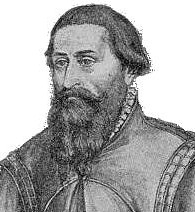
Veit Stoss was a leading German sculptor, mostly working with wood, whose career covered the transition between the late Gothic and the Northern Renaissance. His style emphasized pathos and emotion, helped by his virtuoso carving of billowing drapery; it has been called "late Gothic Baroque". He had a large workshop, and in addition to his own works there are a number by pupils. He is best known for the altarpiece in St. Mary's Basilica in Kraków, Poland.

Archangels are described as the second-lowest rank of angel in De Coelesti Hierarchia written by Pseudo-Dionysius the Areopagite in the 5th or 6th century. The Bible itself uses the term only two times, with no mention in the Old Testament, and does not mention a hierarchy of angels in any detail. The word is usually associated with the Abrahamic religions; similar beings exist in several other religions.
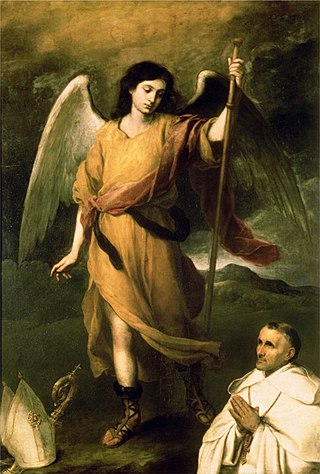
Raphael is an archangel first mentioned in the Book of Tobit and in 1 Enoch, both estimated to date from between the 3rd and 2nd century BCE. In later Jewish tradition, he became identified as one of the three heavenly visitors entertained by Abraham at the Oak of Mamre. He is not named in either the New Testament or the Quran, but later Christian tradition identified him with healing and as the angel who stirred waters in the Pool of Bethesda in John 5:2–4, and in Islam, where his name is Israfil, he is understood to be the unnamed angel of Quran 6:73, standing eternally with a trumpet to his lips, ready to announce the Day of Judgment. In Gnostic tradition, Raphael is represented on the Ophite Diagram.
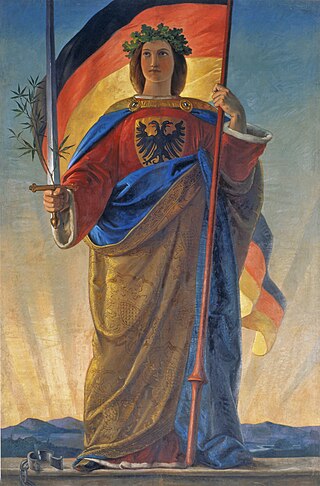
Germania is the name of a painting that was probably created in March 1848. It hung in the St. Paul's Church (Paulskirche) in Frankfurt, Germany. At that time, first the so-called Pre-Parliament and then the Frankfurt National Assembly, the first all-German parliament, met there. The National Assembly was a popular motif of the time, so the Germania painting also became very well-known. After the National Assembly was violently terminated in May 1849, the painting was taken down. In 1867 it was moved to the German National Museum in Nuremberg.

The Germanisches Nationalmuseum is a museum in Nuremberg, Germany. Founded in 1852, it houses a large collection of items relating to German culture and art extending from prehistoric times through to the present day. The museum is Germany's largest museum of cultural history. Out of its total holding of some 1.3 million objects, approximately 25,000 are exhibited.
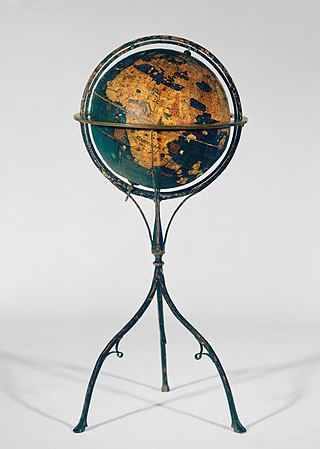
The Erdapfel is a terrestrial globe 51 cm (20 in) in diameter, produced by Martin Behaim from 1490 to 1492. The Erdapfel is the oldest surviving terrestrial globe. It is constructed of a laminated linen ball in two halves, reinforced with wood and overlaid with a map painted on gores by Georg Glockendon. These intricate details were based on navigational charts by Jorge de Aguiar, incorporating paper maps meticulously pasted onto a parchment layer encircling the globe.

Erhard Etzlaub was a German cartographer, astronomer, geodesist, instrument maker, and physician.

Neri di Bicci (1419–1491) was an Italian painter active in his native Florence. A prolific painter of mainly religious themes, he studied under his father, Bicci di Lorenzo, who had in turn studied under his father, Lorenzo di Bicci. The three thus formed a lineage of great painters that began with Neri's grandfather.

Three Archangels with Young Tobias is a painting by the Italian Renaissance painter Filippino Lippi, dated c. 1485. It is housed in the Galleria Sabauda of Turin.
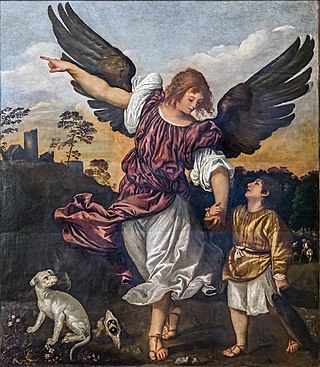
Tobias and the Angel is the traditional title of depictions in art of a passage from the Book of Tobit in which Tobias, son of Tobit, travels with the Archangel Raphael without realising he is an angel (5.5–6) and is then instructed by Raphael what to do with a giant fish he catches (6.2–9). The Book of Tobit is accepted by Catholic and Eastern Orthodox Christians as part of the biblical canon, but not by Judaism or most Protestant Christians, the latter including it in the Apocrypha.
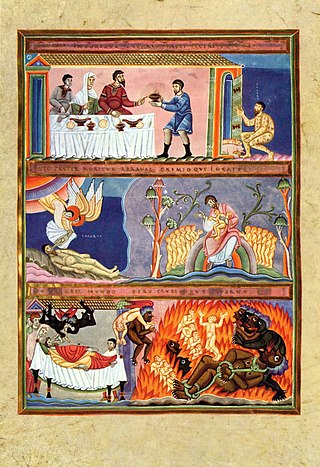
The Codex Aureus of Echternach is an illuminated Gospel Book, created in the approximate period 1030–1050, with a re-used front cover from around the 980s. It is now in the Germanisches Nationalmuseum in Nuremberg.

The Golden Cone of Ezelsdorf-Buch is a Late Bronze Age artefact discovered in 1953 between the villages of Ezelsdorf and Buch in Southern Germany. A tall, cone-shaped object made of thin sheet gold, it is seen as belonging to a group of artifacts referred to as Bronze Age Golden hats. It was presumably worn by special functionaries on ceremonial occasions.

Madonna of the Fish, known also as Madonna with the Fish is a painting by the High Renaissance master Raphael, dated to 1513-14. It is now in the Museo del Prado, Madrid. Mary sits enthroned with Jesus on her knee. On one side is St. Jerome, dressed as a cardinal, kneeling by his attribute, a lion; he is holding his Vulgate translation of the Bible. On the other side the archangel Raphael is presenting at the foot of the throne the young Tobias, whom he had accompanied to the River Tigris, and who bears the miraculous fish whose heart, liver and gall were to restore his father's sight, and drive the demons from his bride.

Christ among the Doctors is an oil painting by Albrecht Dürer, dating to 1506, now in the Museo Thyssen-Bornemisza, Madrid, Spain. The work belongs to the time of Dürer's sojourn in Italy, and was according to its inscription executed incidentally in five days while he was working on the Feast of the Rosary altarpiece in Venice. The work was influenced by Leonardo da Vinci and possibly based on the most probably earlier painting by Cima da Conegliano on the same theme.

The Balkåkra Ritual Object is an item from the Bronze Age found in Balkåkra, Sweden in 1847. Its use and purpose remain unknown.
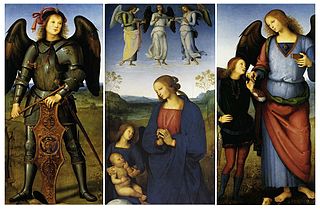
The Certosa di Pavia Altarpiece was an oil on panel altarpiece by Pietro Perugino. It dates to around 1496 to 1500 and three of its panels are now in the National Gallery, London. Art historians believe that the central panel is an autograph copy of the Madonna del Sacco.

The Archangel Raphael Leaving Tobias' Family is a 1637 oil-on-panel painting by Rembrandt, now in the Louvre, in Paris, France. The painting depicts a scene from the Book of Tobit, in which the archangel Raphael departs after guiding Tobias on his journey and helping to cure the blindness of his father, Tobit.
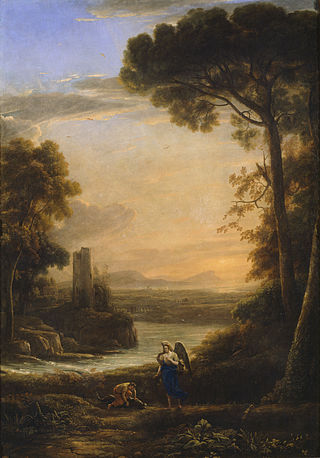
Landscape with Tobias and Raphael is a 1639-40 painting by Claude Lorrain, one of a series of paintings commissioned from the artist for the Palacio del Buen Retiro and now in the Prado Museum in Madrid.

The Martyrdom of Saint Florian is an oil-on-panel painting executed c.1518–1520 by the German artist Albrecht Altdorfer, signed with his "A in A" monogram on a post of the bridge on the right. It and the artist's Saint Florian Taking Leave of the Monastery were in the Spannocchi collection of the Pinacoteca nazionale di Siena until 1914, when they were both transferred to their present home in the Uffizi in Florence to strengthen the latter's holdings on the Northern Renaissance.

The Archangel Raphael and Tobias is an oil painting by Titian of Tobias and the Angel, dated to about 1512 to 1514, which is now in the Gallerie dell'Accademia in Venice. Another painting by Titian of the same subject, entitled Tobias and the Angel, dated to about 1540 to 1545, remains in the church of the Madonna dell'Orto in Venice.



















